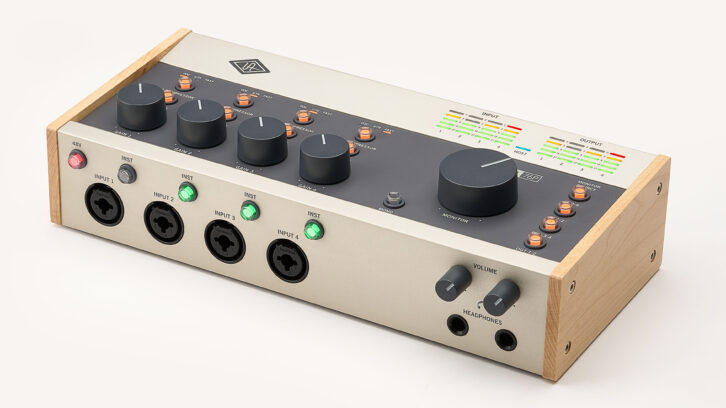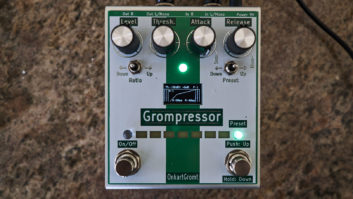
| MIX VERDICT: UNIVERSAL AUDIO VOLT 476P AUDIO INTERFACE |
| THE TAKEAWAY: “The new Volt flagship—and the Volt line in general—offer UAD’s analog modeling and interface technology for a lower cost-per-channel than you’d have to pay for an Apollo.” |
| COMPANY: Universal Audio • www.uaudio.com PRICE: $469 PROS: • Low price. • Four mic/line/instrument preamps with switchable Vintage mode. • Switchable 76 Compressor. • Compact, well-designed tabletop unit. • Mono button. • Monitor output pair plus four line outputs. • Large knobs and switches. CONS: • No expansion ports. • Phantom power can only be switched on or off globally. • Headphone outputs not independently addressable. • No source/DAW knob for direct monitoring. |
The Universal Audio Volt range represents the company’s first foray into native audio interfaces. The USB-C Volt units are tabletop-style devices designed for personal recording, podcasts and other low-input-count applications. Because they don’t have the built-in hardware acceleration required to run UAD plug-ins and its Console software, the Volts are much less expensive than other UA interfaces.
The basic Volt models, the 1×2 Volt 1 and 2×2 Volt 2, come with built-in Vintage Mic Preamp mode, which provides a switchable emulation of the Universal Audio 610 mic pre. The Volt 176 and 276 also include 1176-style compressors on their inputs.
UA just released two new models, the 4×4 Volt 476, featuring two mic preamps and two line inputs, and the 4×4 Volt 476P (Mac/ Windows/iOS), which is the subject of this review and is the only Volt so far with four mic preamps. It also adds more flexibility on the output side with a stereo monitor output and two pairs of TRS line outs.
MAKING CONNECTIONS
The rectangular-shaped Volt 476P is about 10.5 inches wide by 4.5 inches deep and has feet on the bottom to keep it from sliding. Some of the smaller Volt models are USB-C bus powered, but because of its internal processing, the 467P comes with a 5VDC power adapter, which plugs in on the back.
The unit’s front panel houses the four XLR/TRS combo jacks to handle mic, line or instrument-level signals. For the latter, you press the corresponding INST button that sits above the jack, which turns green to indicate it’s on.
Also on the front panel is a global 48V phantom power button that lights up red when activated. I would have preferred individual phantom power switches or the ability to switch on only two at a time. However, at this price point, UA had to make some sacrifices. The unit also lacks a pad, a highpass filter or a polarity invert switch, all of which you get on Apollo interfaces.
On the far right of the 476P are a pair of 1/4-inch TRS headphone outputs, each with its own volume control. They’re not separately addressable, however.

The back panel contains six 1/4-inch outputs: Monitor L and R, and four line outputs. The extra outputs allow you to feed a separate headphone amp or other outboard gear.
Also on the back are MIDI In and Out ports on 5-pin DIN connectors. I haven’t used a MIDI cable in years because I always plug my controller in over USB, but if your setup requires actual MIDI cables, you’ll be happy the ports are there.
Finally, the back features the USB-C port for connecting to your computer, a power jack for the included adapter, and a large, horizontally oriented Off/On switch that’s easy to locate when you reach your hand around to the back of the unit.
ON TOP OF THINGS
As with many tabletop interfaces, most controls are on the top panel. Each channel has a good-sized Gain knob for adjusting the input level. Above each Gain knob is a button labeled Vintage for turning on the 610 mic preamp emulation and one labeled 76 Compressor for turning on the 1176 FET-style compression.
The Vintage effect is relatively subtle but provides a slightly thicker and warmer sound. It’s nice to have sonic options when tracking.
UA equipped the 76 Compressor with three preset modes for attack and release times: Mic, GTR and Fast. Successive button presses step you through the presets and turn off the effect. Above the Compressor knob on each channel are indicator LEDs that show which preset is active.
The excellent-sounding 76 Compressor effect is less subtle than the Vintage preamp emulation. It raises the level and squashes the peaks. You can use it to control a source with a wide dynamic range, but it will probably be most beneficial for the color it adds.
I found it improved the sound of virtually any source I recorded through it, including vocals, guitars, mandolin and bass.
Because the processing happens on input, you’re committing to the compression. If you’d prefer to be more conservative, you could leave the compressor off and add a FET compressor when you’re mixing.
However, I’d be willing to bet that most users will leave it on most of the time because it sounds quite good on any source.
MONITORING SOURCE
The top panel also features a pair of 5-level, ladder-style meters for Input and Output. Below are a large Monitor level knob and four Monitor Source buttons that you use to set up the direct monitoring.
Typically, audio interfaces have one of two types of monitoring setups. Many units (including the Apollo series) offer DSP-based mixers you run on your computer to control monitoring levels and create multiple monitor mixes.
Interfaces with small channel counts often use a different method, which features a monitor/source knob, which you use to control the direct signal level versus the audio coming back from your DAW. That allows you to hear the voice or instrument you’re playing without the latency you’d experience if you monitored through your DAW.
On the Volt, monitoring is similar to the second type. You select one or more Monitor Source buttons to hear the direct signal from Inputs 1-2 and 3-4. You choose an output button (or buttons) to control which DAW outputs you want in the headphone mix.
Flock Audio Patch LT – A Real-World Review
When you engage any combination of the Input and Output source switches, Volt automatically reduces the level of the DAW return in the headphone outputs to allow you to hear the track you’re recording. There’s no knob to change the ratio of the direct signal to DAW return. However, you can achieve the same result by adjusting your DAW software’s output level and the Volt’s headphone control.
Any of the four mono inputs feed into stereo output pairs 1-2 or 3-4. As a result, you’ll hear any mono source you’re recording panned entirely left or right, depending on which input you’re using. If you find that distracting, you can press the global Mono button, which pans all the inputs (not the returning DAW output) into the center.
The headphone outputs aren’t addressable separately, so if you want more than one headphone mix, the most practical way would be to record with your DAW’s buffer low enough to keep the latency comfortably low, then send one mix to Outputs 1 and 2 and the other to 3 and 4, while connecting the latter pair to a headphone amp using the line outputs on the back of the Volt 476.
SIZING IT UP
Although you can’t run UAD plug-ins on Volt interfaces, UA does include a software bundle that contains feature-reduced versions of software and plug-ins, including Ableton Live 11 Lite, Celemony Melodyne Essential, Relab LC480 Essentials, Plugin Alliance Ampeg SFT-VR Classic, Marshall Plexi Classic and the Time and Tone Bundle from Softube, Virtual Drummer Deep and Virtual Bassist Dandy from UJam, and the Labs instrument collection from Spitfire Audio.
Volt owners also get a 30-day free trial of UAD Spark, which features a growing collection of native UAD plug-ins.
I recorded with the Volt 476P on several projects in my studio and found it extremely capable. I was consistently pleased with the results on a variety of sources, both DI and miked. The Vintage mode and the 76 Compressor options were quite handy for recording tracks with added sonic character.
Based on its I/O count, I wonder a bit about the target market. Most four-preamp interfaces out there offer ADAT expansion ports, so you can increase channel count when needed by connecting another compatible preamp or interface. Without that capability, the 476’s 4×4 architecture puts it in a “tweener” category. Four inputs aren’t enough for a large session but may be overkill for many people who record on their own. The latter might opt for the less expensive 2×2 Volt 276.
However, with its four inputs and outputs (and Compressor and Vintage mode for added spice), you could use the 476P as a killer standalone preamp feeding another interface in a multi-input session.
The headline here is that the 476P, the new Volt flagship—and the Volt line in general—offer UAD’s analog modeling and interface technology for a lower cost per channel than you’d have to pay for an Apollo. If you want UAD plug-ins to go along with it, you can get a subset of them via a Spark subscription. Between Volt and Spark, the price of entry into the UAD world has dropped significantly.







